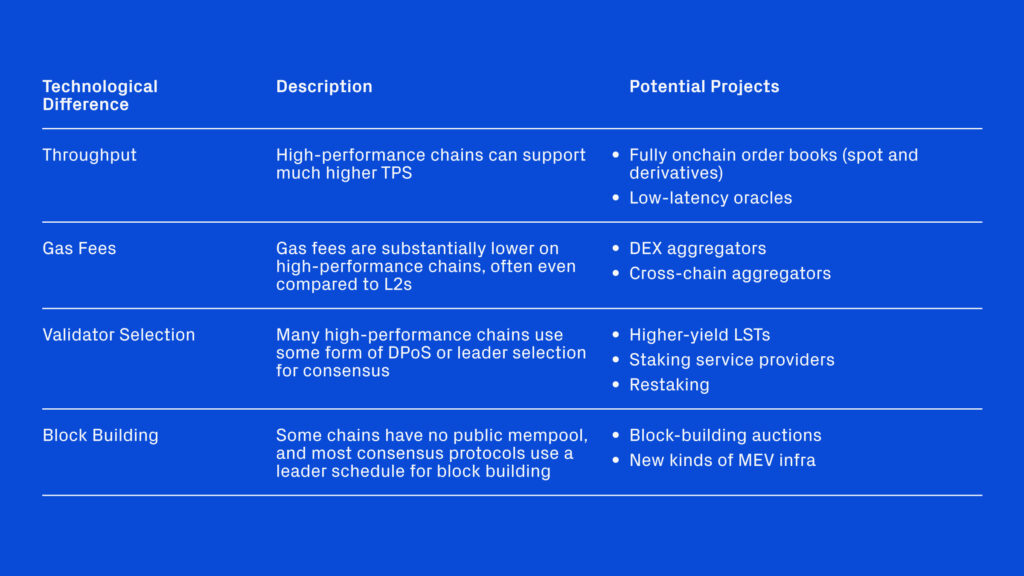Derek Walkush

DeFi Opportunities on High-Performance Chains
Thanks to growth in L2s, the Ethereum ecosystem remains where the majority of DeFi resides. However, the recent success of Solana, Aptos, and other high-performance chains suggests they will play a major role in DeFi moving forward.
But high-performance chains are different from Ethereum in ways that DeFi builders seasoned in the Eth ecosystem may not fully appreciate.
Below I discuss what I believe are the four most important technical differences as they relate to DeFi projects. Builders who understand these features of high-performance chains will be able to jump on opportunities that might not be viable on the familiar playground of Ethereum.
#1: Throughput
One of the defining features of high-performance chains is extremely high TPS. This technological improvement unlocks a suite of DeFi apps not possible on Ethereum mainnet. Fast finality is extremely difficult to achieve on current Ethereum L2s, due to not only proof generation (zk) and fraud-proof dispute (op) times, but also 12s finality on mainnet. Thus, for the time being, high-performance chains are the only viable location for fully onchain order books. Parallelism of the order book, through dynamic parallelism of techniques like Block-STM, allows newer CLOBs (such as Econia) the ability to minimize contention and maximize throughput.
To be “fully onchain,” the order book must be able to support not only trade settlement (moving of assets between wallets) but also the matching engine (where traders place their bids). The latter is much more difficult to host onchain, as order books must absorb a lot of spam. While requiring much better liquidity and throughput compared to AMMs, order books offer a much more capital-efficient market structure for trading as they don’t require passive LPs.
There’s another opportunity for new projects: While spot DEXs price assets on the order book, DEXs with synthetic derivatives often require external infrastructure for price feeds, i.e., oracles. While high-performance oracles are emerging, many legacy ones can’t support the latency required for chains with <1s finality.
#2: Gas fees
Lower gas fees, combined with high throughput and low latency, have many implications for DeFi application builders on high-performance chains, especially DEX aggregators.
Aggregators fetch the best price from a variety of onchain — and even offchain — liquidity sources. But due to high gas and higher latency on Eth mainnet, the price can often only be retrieved from one DEX / offchain source.
However, on high-performance chains, low fees and low latency allow aggregators to find the best price for an asset across different liquidity venues. In other words, an aggregator can swap tokens on one DEX, then swap again on another DEX if that path offers the best price — or go through even more complex paths. Thus, aggregator pricing is more competitive on high-performance chains than on mainnet.
The story of Solana is quite telling. Jupiter, Solana’s leading aggregator, controls around 80% of trade flow (after filtering out bots). This is in stark contrast to Eth mainnet, where significant trade flow still goes through DEX front ends, and multiple aggregators control ~40-50% of order flow, with no individual front end controlling more than 30-40%. This implies that liquidity and order flow naturally decouple on high-performance chains; aggregators will always fetch the best prices across multiple venues for one swap, which introduces a natural incentive to not build out their own liquidity (it likely wouldn’t offer the best pricing). Liquidity sources (e.g., AMMs, order books) can attempt to build their own proprietary order flow, but they’ll likely not compete on pricing with a leading aggregator.
Moreover, advances in bridging infrastructure and intents-based protocols enable an even higher layer to potentially emerge: cross-chain aggregators for high-performance chains. With activity increasingly spread across different L1s and completely different architectures than the Eth ecosystem, there seems to be a place for a separate cross-chain aggregator.
Thus, aggregators on high-performance chains are winner-take-most — and a massive opportunity.
#3: Validator selection
To support extremely high TPS, many high-performance chains compromise on decentralization in their consensus protocols. They can achieve higher scalability through DPoS, validator clusters, etc, effectively improving the speed of transaction propagation by not broadcasting to an entire large node network.
As part of their consensus protocols, many high-performance chains use a deterministic leader schedule — a predefined set of validators tasked with ordering transactions in blocks. Transaction ordering thus becomes extremely dependent on validators selected as leaders, as they’re in an exclusive and predetermined position. This is different from Ethereum, where validators are selected pseudo-randomly.
Leaders or delegates are selected in a variety of ways, but the result of deterministic leader schedules is that certain validators can build more blocks and earn greater rewards, which is self-reinforcing — these validators often accrue even more stake. Additionally, given more intense requirements for state access (to support high TPS, parallelization, etc), high-performance chains often have much higher hardware requirements, meaning the barrier to entry (in the form of upfront costs) for validators is greater.
This dynamic creates a series of advantages for staking broadly, and particularly for liquid staking tokens. (While validator selection on Ethereum is extremely important, it often does not have a large impact on overall staking yields.) Essentially, some LSTs with access to the best validators can have a structural advantage through higher yields. There’s also an opportunity for high-performance chains to embrace an equivalent to Ethereum’s shared security / restaking layer, enabling projects with access to the best validators to further increase their yields via restaking.
#4: Block building / ordering
The block-building process differs chain by chain, but broadly, there are major structural differences between high-performance chains and Eth mainnet, creating large implications for MEV.
The use of predetermined leader schedules or delegates for validating transactions can create challenges for transaction inclusion. First in first out (FIFO) models sometimes require searchers to spam the chain with transactions to try and get them included first, versus being able to deliberately order transactions through bundles. Different gas fee market designs (notably Solana’s local fee markets) also mean priority fees don’t always increase the chances of a transaction being included. These architectures make it challenging to execute MEV strategies like sandwich attacks.
Additionally, some chains — notably Solana — don’t have a public mempool, making it more difficult for external MEV searchers to survey transactions and order them to execute MEV strategies. Pipelined and parallel blockchains like Aptos can potentially disrupt sandwich attacks by randomly reordering transactions prior to the parallel execution stage of processing.
Thus, the MEV opportunity on high-performance chains is structurally different. Slight differences in chain architectures often have substantial impacts on MEV. Block-building auctions, such as Jito’s on Solana, continue to be a large opportunity for builders. These architectures create opportunities for new kinds of MEV infrastructure, but the topic is still being researched and is not nearly as deeply understood as MEV on mainnet.
Wrapping Up
Many high-performance chain ecosystems are so early that they have roughly tracked the development of Ethereum DeFi. However, the slight divergences mentioned above (there are likely many others I didn’t discuss) could dramatically impact the trajectory of certain sectors, creating massive opportunities for DeFi builders.
Thank you to Mert (Helius), Lucas (Jito), and Avery (Aptos Labs) for reviewing this piece.
+++
This post is for general information purposes only. It does not constitute investment advice or a recommendation or solicitation to buy or sell any investment and should not be used in the evaluation of the merits of making any investment decision. It should not be relied upon for accounting, legal or tax advice or investment recommendations. You should consult your own advisers as to legal, business, tax, and other related matters concerning any investment. Certain information contained in here has been obtained from third-party sources, including from portfolio companies of funds managed by Variant. While taken from sources believed to be reliable, Variant has not independently verified such information. Variant makes no representations about the enduring accuracy of the information or its appropriateness for a given situation. This post reflects the current opinions of the authors and is not made on behalf of Variant or its Clients and does not necessarily reflect the opinions of Variant, its General Partners, its affiliates, advisors or individuals associated with Variant. The opinions reflected herein are subject to change without being updated.

